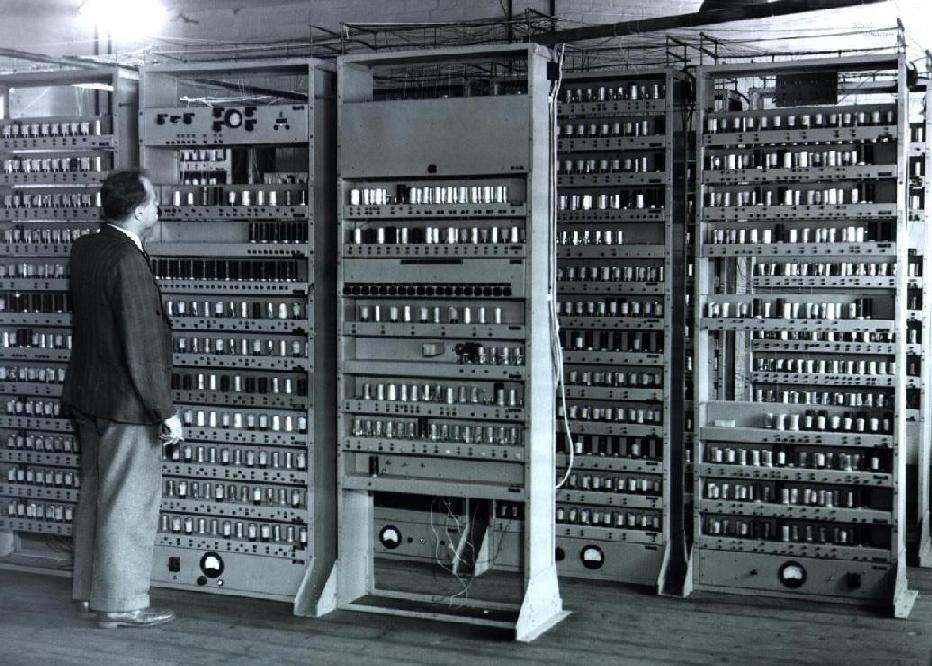The following outline is provided as an overview of and topical guide to computing:
Computing – activity of using and improving computer hardware and software.
Computer Science (see also Outline of computer science)
Information Technology – refers to the application (esp in businesses and other organisations) of computer science, that is, its use by mankind (see also Outline of information technology)
Information Systems – refers to the study of the application of IT to business processes
Computer engineering (see also Outline of computer engineering)
Software engineering (see also Outline of software engineering)
The Digital Bibliography & Library Project, as of July 2007, lists over 910,000 bibliographic entries on computer science and several thousand links to the home pages of computer scientists. Common topics include:
Computer science
Theory of computation
Computational models
Scientific computing
Metacomputing
Autonomic Computing
See information processor for a high-level block diagram.
Computer
Computer hardware
History of computing hardware
CPU design
Computer network
After the commoditization of memory, attention turned to optimizing CPU performance at the instruction level. Various methods of speeding up the fetch-execute cycle include:
designing instruction set architectures with simpler, faster instructions: RISC as opposed to CISC
Superscalar instruction execution
VLIW architectures, which make parallelism explicit
Software engineering
Computer programming
Computational
Software patent
Firmware
System software
Device drivers
Operating systems
Utilities
Application Software
Databases
Geographic information system
Spreadsheet
Word processor
Programming languages
interpreters
compilers
assemblers
Speech recognition
Speech synthesis
History of computing hardware from the tally stick to the quantum computer
History of computer science
Punched card
Unit record equipment
IBM 700/7000 series
IBM 1400 series
IBM System/360
History of IBM magnetic disk drives
Accounting software
Computer-aided design
Computer-aided manufacturing
Computer-assisted dispatch
Customer relationship management
Data warehouse
Decision support system
Electronic data processing
Enterprise resource planning
Geographic information system
Hospital information system
Human resource management system
Management information system
Material requirements planning
Product Lifecycle Management
Strategic enterprise management
Supply chain management
Utility Computing
Accessible computing
Computer-induced medical problems
Computer user satisfaction
Human-computer interaction
Human-centered computing
Wired and wireless computer network
Types
Wide Area Network
Metropolitan Area Network
City Area Network
Village Area Network
Local Area Network
Wireless Local Area Network
Mesh networking
Collaborative workspace
Internet
Network Management
The main goal of CbWN is to optimize the system performance of the flexible wireless network.
Source coding
Codebook design for side information based transmission techniques such as Precoding
Wyner-Ziv coding for cooperative wireless communications
Security
Dirty paper coding for cooperative multiple antenna or user precoding
Intelligence
Game theory for wireless networking
Cognitive communications
Flexible sectorization, Beamforming and SDMA
Software
Software defined radio (SDR)
Programmable air-interface
Downloadable algorithm: e.g., downloadable codebook for Precoding
Cryptology – cryptography – information theory
Cracking – demon dialing – Hacking – war dialing – war driving
Social engineering – Dumpster diving
Physical security – Black bag job
Computer insecurity
Computer surveillance
Defensive programming
Malware
Security engineering
integral data types – bit, byte, etc.
real data types:
Floating point (Single precision, Double precision, etc.)
Fixed point
Rational number
Decimal
Binary-coded decimal (BCD)
Excess-3 BCD (XS-3)
Biquinary-coded decimal
representation: Binary – Octal – Decimal – Hexadecimal (hex)
Computer mathematics – Computer numbering formats –
storage: Character – String – text
representation: ASCII – Unicode – Multibyte – EBCDIC (Widecharacter, Multicharacter) – FIELDATA – Baudot
Data compression
Digital signal processing
Image processing
Data management
Routing
Data Protection Act
There are several terms which describe classes, or categories, of computers:
Analog computer
Calculator
Desktop computer
Desktop replacement computer
Digital computer
Embedded computer
Home computer
Laptop
Mainframe
Minicomputer
Microcomputer
Personal computer
Portable computer
Personal digital assistant (aka PDA, or Handheld computer)
Programmable logic controller or PLC
Server
Smartphone
Supercomputer
Tablet computer
Video game console
Workstation
Apple
Asus
Avaya
Dell
Fujitsu
Gateway Computers
Groupe Bull
HCL
Hewlett-Packard
Hitachi, Ltd.
Intel Corporation
IBM
Lenovo
Microsoft
NEC Corporation
Novell
Panasonic
Red Hat
Silicon Graphics
Sun Microsystems
Unisys
Acorn, bought by Olivetti
Amdahl Corporation, bought by Fujitsu
Bendix Corporation
Burroughs Corporation, merged with Sperry to become Unisys
Compaq, bought by Hewlett-Packard
Control Data
Cray
Data General
Digital Equipment Corporation, bought by Compaq, later bought by Hewlett-Packard
Digital Research – produced system software for early Intel microprocessor-based computers
English Electric Company
Ferranti
General Electric, computer division bought by Honeywell, then Bull
Honeywell, computer division bought by Bull
ICL
Leo
Lisp Machines, Inc.
Marconi
Micro Instrumentation and Telemetry Systems produced the first widely sold microcomputer system (kit and assembled)
Nixdorf Computer, bought by Siemens
Norsk Data
Olivetti
Osborne
Packard Bell
PERQ
Prime Computer
Raytheon
Royal McBee
RCA
Scientific Data Systems, sold to Xerox
Siemens
Sinclair Research, created the Sinclair ZX Spectrum, ZX80 and ZX81
Southweat Technical products Corporation produced microcomputers systems (kit and assembled), peripherals, and software based on Motorola 6800 and 6809 microcomputer chips
Sperry, which bought UNIVAC, and later merged with Burroughs to become Unisys
Symbolics
UNIVAC
Varian Data Machines, a division of Varian Associates which was bought by Sperry
Wang
Open standards
See also Open standard
Apdex Alliance – Application Performance Index
Application Response Measurement (ARM)
Bill Gates
Paul Allen
Steve Jobs
Steve Wozniak

